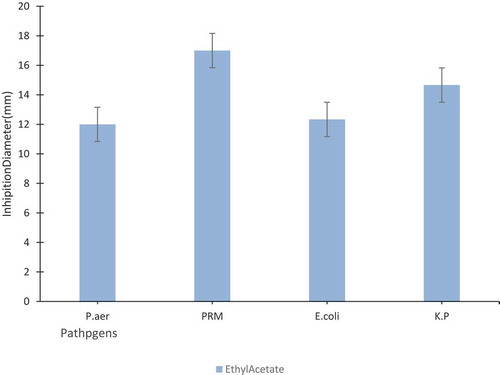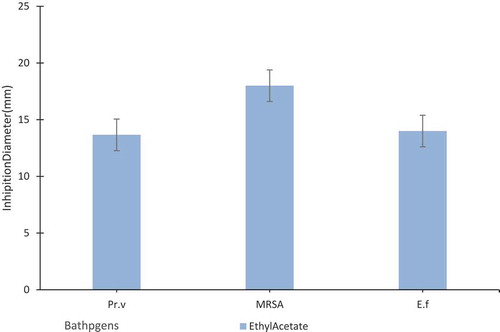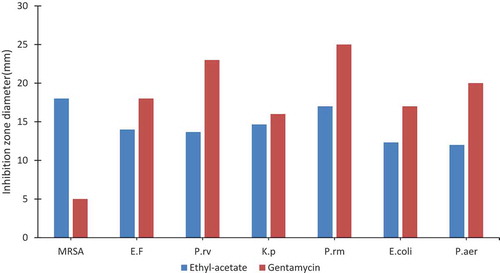Abstract
Antibiotic resistance is one of the biggest hazards globally that is leading to prolonged hospital stay, inflated medical expenditures and increased morbidity and mortality. Many natural compounds have intrinsic antibacterial activity which needs to be exploited for their clinical use. Given its nutritional value, Date palm is considered as an essential nourishing source in many countries while the Date seed beverage is consumed locally to promote the health. The aim of our research is to assess the active constituents from date palm seed cake for their antimicrobial activity. Extraction of the date seed powder using high polarity solvents i.e. hexane and ethyl-acetate using cold extraction method. The isolates were later assessed for antibacterial activity against Gram-positive and Gram-negative bacteria using agar-well diffusion method.The ethyl-acetate extract in a 10% Dimethyl sulfoxide exhibited effective inhibition of bacterial growth in comparison with gentamycin. Potential antibacterial activity of ethyl acetate extract was observed against numerous Gram positive pathogens.
KEYWORDS:
PUBLIC INTEREST STATEMENT
The emergence of bacterial antibiotic resistance is a serious challenge as it leads to the development of bacterial strains that cannot be killed by the contemporary antibiotics arsenal. If this trend continues, we may face a future with antibiotics having lessening effectiveness. According to the recently published report from the Centre for Disease control (CDC, 2017); necessary measures are being adopted to curtail the spread of antibiotic resistance that includes research to find out novel molecules with antibacterial activity. Our study is an attempt to show that date seed cake, which is currently being used extensively to treat various diseases in the Arab countries, also possess antibacterial activity. Amongst the wide strains of bacteria used in our study, we found that Gram-positive bacteria showed the highest sensitivity. Although the extract showed little effectiveness against Gram-negative bacteria in general. These are encouraging data which necessitate further investigation.
Competing interests
The authors declare no competing interests.
Introduction
Antimicrobial resistance poses a huge threat worldwide. Injudicious use of antibiotics has resulted in the loss of numerous antibiotics during the last few decades. Approximately 500,000 persons have developed drug-resistant tuberculosis (TBmalaria, malaria, and human immunodeficiency virus infection in 2016 (World Health Organization, Citation2018). The natural resistance of microbes occurs over time, through genetic mutations, however; however, the increasing misuse of antimicrobials has significantly contributed to the process. In many places, antibiotics are and injudiciously used humans and animals, and often without supervision (World Health Organization, Citation2018).
Numerous plants that are consumed in our regular diet can be utilized to avoid and/or treat disease and many health problems safely and effectively. Al-Alawi and colleagues have recently reported antibacterial, antioxidant, antifungal, and antiproliferative properties of date palm fruits (Al-Alawi, Al-Mashiqri, Al-Nadabi, Al-Shihi, & Baqi, Citation2017).
One of the major yields in Southwest Asia and North Africa is the date palm tree (Phoenix dactylifera) (Al- et al., Citation2014; Chao & Krueger, Citation2007; Hazzouri et al., Citation2015). Date palm natural products are that contains a single seed encased by and meaty (Al-Qarawi, Mousa, Ali, Abdel-Rahman, & El-Mougy, Citation2004; Barghini, Gioia, Fava, & Ruzzi, Citation2007). The date natural products are profoundly sustaining and may have various potential medical advantages when used alone or in combination with therapeutic herbs (Tiwari, Brunton, & Brennan, Citation2013). In the past, dates were considered an integral part of the diet due to their high mineral and vitamin contents. Date seeds contain ingredients with nutritional value (El Hadrami, Daayf, & El Hadrami, Citation2011). Roasted and ground date seeds are utilized by certain local community as coffee alternates and in the form of coffee-like preparations produced using date seeds in several Arabian shops as in the Kingdom of Saudi Arabia (Cohen, Givataim, Herzelia, & Shimshit, Citation2011). The date fruit and their derivatives such as seed, and are full of fiber, selenium, carotenoids, ascetic and other antioxidants that may avoid the oxidative damage arising from pathogens. The seed powder is also used as a coffee substitute and as food supplements (Bellakhdar, Citation1997).
A review of literature spanning over the last four decades revealed a plethora of reports on the nutritional value of dates and their chemical composition (Besbes, Blecker, Deroanne, Drira, & Attia, Citation2004). This has generated an increasing interest in the utility of seeds, which often disposed of or used as animal feed (Besbes et al., Citation2004). It is the source of several components such as citric acid, ethanol, estrone, and alkali-soluble polysaccharide. The seeds also yield essential fatty acids such as acid, palmitic acid, stearic acid, lauric acid, oleic acid, and linoleic acid in addition to traces of acid (Al-Khayri & Naik, Citation2017). Phenolic acids, flavonoids, tannins, and have also been found in date fruit in large amount (Martín-Sánchez et al., Citation2014). Experimental data and the phytochemical composition analysis show that can have potential anticancer benefits against numerous types of and intestinal diseases (Al-Sayyed, Takruri, & Shomaf, Citation2014; Benchelah & Maka, Citation2006). Additionally, the antibacterial activity of the date extract has been reported (Samad et al., Citation2016).
Rich in phenolic contents, dates are known to have antiviral, antibacterial, and antifungal properties, making them a possible source of compounds for the treatment and prevention of infections.
Due to increase in the number of microorganisms resistant to drugs and antibiotics, there is an urgent need of modification of existing antibiotics and antifungal agents, updating of antimicrobial form or formula, and adding new antimicrobial agents for use in the clinics (Boulenouar, Marouf, & Cheriti, Citation2009).
More recently, there is immense interest in the use of nutritive in human health (Hertog et al., Citation1995).
Aim and objective
The primary aim of this study was to evaluate and assess date palm seed cake extract which is used as in the local community for potential antibacterial activity.
Materials and method
The date seed was extracted by using ethyl acetate and hexane.
Date seed powder of 200 g was added to 400 ml of and incubated in a shaker at room temperature. After 24-h incubation, the solvent was filtered from the mixture, and the powder was dried and used again for extraction using 400 ml ethyl acetate by incubating for 24 h in a shaker. The solvent was filtrated and saved in a closed flask. The ethyl acetate extract was evaporated under reduced pressure using a rotary evaporator, and the residue was dissolved in 10% Dimethyl sulfoxide (DMSO) to achieve the final concentration of 100 mg/ml. The extract was used for antibacterial activity using the agar well diffusion techniques against standard antibiotic () and a negative control (DMSO 10%).
Bacterial strains
The bacterial strains used in this study included Pseudomonas aeruginosa, Escherichia coli, Klebsiella pneumonia, Proteus vulgaris, Proteus mirabilismethicillin-resistant Staphylococcus aureus (MRSA), and Enterococcus faecalisAll bacterial strains were identified and confirmed previously by College of Applied Medical Sciences Lab in Qassim University.
5. Preparation of microbial cultures and agar well diffusion method
Three bores with diameter of 6 mm were cut into the agar medium using a heat sterile Pasteur pipette. The agar plates were then used for bacterial culture by streaking a medical swab soaked in the respective bacterial suspension. One bore was filled with 50 μl of the seed extract, and the other bores were filled with the positive (gentamycin) and negative controls (DMSO 10%). After 1-h diffusion, the bacterial cultures were incubated at 37°C for 24 h. The diameters of the growth inhibition zones were measured in mm. All of the tested organisms were repeated three times on different days.
6. Statistical analysis
Microsoft Excel was used for statistical purposes. Data were expressed as mean and standard deviation.
7. Result
Antimicrobial potential of ethyl acetate extract date palm seed cake is shown in Table and Figures –). It is obvious that ethyl acetate showed significant and differential antibacterial effects.
Table 1. Inhibition zones of bioactive compounds of Phoenix dactylifera L. against various pathogenic bacteria using ethyl acetate extract at 100 mg/ml concentration after 24 h incubation at 37ºC
Depending on the diameter of the inhibition zone, the antibacterial activity has been classified into four categories (antibacterial activity results have been expressed in mm):
• ≤10 mm considered as low activity.
• >10 to 15 mm considered as moderate activity.
• >15 to 20 mm considered as strong activity.
• >20 mm considered as extremely strong.
The most susceptible microbes for the date seed extracts were the gram-positive bacteria, while the gram-negatives showed less susceptibility (Figures and ).
MRSA was extremely sensitive to the seed extract as compared to gentamicin control, followed by E. faecalis (Figure ). Gram-negative bacterial culture of E. coli and P.aeruginosa revealed little degree of susceptibility against extract, while P. mirabilis shows more (Table and Figures –).
8. Discussion
Although the antibacterial activities were investigated and determined by several studies (Al-Alawi et al., Citation2017; Al-Qarawi et al., Citation2004; Barghini et al., Citation2007), no one study has investigated this activity against defined bacteria. This study has investigated the antibacterial activities of date palm cake extracts against gram-negative bacteria and gram-positive bacteria.
As it is evident from the results, the date seed extract in ethyl acetate produced significant effect against various infectious bacteria that were obtained from patients suffering from infectious diseases. These antibacterial properties were related to the presence of many beneficial phytochemical constituents.
Generally, the antibacterial action of date seed cake in this report is credited to its phytochemical elements that may possibly include phenols, alkaloids, flavonoids, and tannins (Martín-Sánchez et al., Citation2014)
Some important published studies support our findings. A recent antimicrobial study of leaf extracts of date palm trees in Saudi Arabia reported the potential antimicrobial effect of the date palm (Abdallah, Musa, Qureshi, & Sadeek, Citation2017).
According to the diameter of the inhibition zone, the antibacterial activity can be divided into four categories, i.e., mild, moderate, strong, and extremely strong. The results shown in Table present antimicrobial activities against gram-negative and gram-positive bacterial species, and the mean diameter of the inhibition zone was from 12 to 18 mm. The gram-positive bacteria showed a significantly higher sensitivity to the date palm seed extract, while the gram-negative bacteria were less susceptible (Figures 2 and 3). The MRSA showed the strong susceptibility as indicated by a large zone of growth inhibition of 20 mm diameter as compared to the positive control (gentamycin).
These data are in line with the already published results (Gaceb-Terrak, Citation2010).
The observed diversity in the diameter of the inhibition zone may be explained by the difference of the solubility and polarity of the material in each solution or by the difference in the mass of bacteria grown each time. Some earlier studies advocate the difference from little to high antimicrobial activity identified from the plant extracts to the less strength of polarity of the composites due to the method of extraction (Nazif, Citation2002).
A study examining the seed extract showed a strong effect of the ethyl acetate date seed extract in inhibition of the microorganism (Trigui, Hsouna, Tounsi, & Jaoua, Citation2013).
Another similar study has shown that methanol and ethanol extracts of the date palm leaves have antibacterial activities against many gram-positive and gram-negative bacteria including Streptococcus pneumoniae, E. coli, and Klebsiella pneumonia (Abdulmajeed et al., Citation2013).
On the same note, methanol and acetone extracts from date leaves have been shown with significant antibacterial activity against E. coli, P. aeruginosa, Shigella flexneri, Staphylococcus aureus, Streptococcus pyogenes, and Bacillus subtilis (Perveen, Bokhari, & Soliman, Citation2012).
We anticipate that our results, supported by the previously published studies, will provide an excellent basis for future research for the exploitation of date seed cake and paved the way to study the effectiveness of this product against antibiotic-resistant infections.
9. Conclusion
In conclusion, our results show the antibacterial properties of the date seed cake extract against a wide spectrum of bacteria. Among the tested bacteria, gram-positive bacteria MRSA showed the highest sensitivity followed by E. Faecalis. The results of MRSA are very encouraging as the extract was more effective than the control antibiotic (gentamycin). On the other hand, although the extract showed little effectiveness against gram-negative bacteria in general, P. mirabilis showed more sensitivity.
Additional information
Funding
Notes on contributors
Maha ALrajhi
Maha ALrajhi From prolonged hospital stay to inflated medical expenditures and increased morbidity/mortality, antibiotic resistance has serious implications on the system from the global perspective. Given the clinical significance of the topic of bacterial antibiotic resistance, our research group is involved in in general with a primary focus on bacterial resistance to antibiotics. Our present study is a continuation of our research efforts to explore the natural compounds for their intrinsic antibacterial activity. At, we have previously t8507 protein-A (spa) gene (partial; Genbank Accession No: KJ0000570) and protein A (partial; Protein Accession No: AHI88411). We have also published the molecular typing and antibiotic resistance patterns of methicillin-resistant Staphylococcus aureus isolates from the clinical samples. Our results from the present study are encouraging, and we are designing future experiments to adventure more extensive assessment of the antibacterial activity of date cake extract against of both gram-negative and gram-positive bacteria.
References
- Abdallah, E., Musa, K., Qureshi, K., & Sadeek, A. (2017). Antimicrobial activity and antioxidant potential of the methanolic leaf extracts of three cultivars of date palm trees (Phoenix dactylifera) from Saudi Arabia. Medicine Science,International Medical Journal, 1, 5-6.
- Abdulmajeed, N., & Abbas, N. (2013). Antibacterial activity of Phoenix dactyliferaL. leaf extracts against several isolates of bacteria. Journal of Veterinary Science, 4(2), 45–8.
- Al-Alawi, R., Al-Mashiqri, J., Al-Nadabi, J., Al-Shihi, B., & Baqi, Y. (2017). Date palm tree (Phoenix dactylifera L.): Natural products and therapeutic options. Frontiers in Plant Science, 8. doi:10.3389/fpls.2017.00845
- Al-Harrasi, A., Rehman, N. U., Hussain, J., Khan, A. L., Al-Rawahi, A., Gilani, S. A., Al-Broumi, M., & Ali, L. (2014). Nutritional assessment and antioxidant analysis of 22 date palm (Phoenix dactylifera) varieties growing in Sultanate of Oman. Asian Pacific Journal of Tropical Medicine, 7, 591–598. doi:10.1016/S1995-7645(14)60294-7
- Al-Khayri, J., & Naik, P. (2017). Date palm micropropagation: Advances and applications. Ciência E Agrotecnologia, 41(4), 347–358. doi:10.1590/1413-70542017414000217
- Al-Qarawi, A. A., Mousa, H. M., Ali, B. H., Abdel-Rahman, H., & El-Mougy, S. A. (2004). Protective effect of extracts from dates (Phoenix dactylifera L.) on carbon tetrachloride–induced hepatotoxicity in rats. International Journal of Applied Research in Veterinary Medicine, 2, 176–180.
- Al-Sayyed, H. F., Takruri, H. R., & Shomaf, M. S. (2014). The effect of date palm fruit (Phoenix dactylifera L.) on 7, 12-dimethylbenz (α) anthracene (DMBA)-induced mammary cancer in rats. Research Opinions in Animal & Veterinary Sciences, 4(1), 11–18.
- Barghini, P., Di Gioia, D., Fava, F., & Ruzzi, M. (2007). Vanillin production using metabolically engineered Escherichia coli under non-growing conditions. Microbial Cell Factories, 6, 1475–2859. doi:10.1186/1475-2859-6-13
- Bellakhdar, J. (1997). Moroccan traditional pharmacopoeia: Ancient Arabic medicine and popular knowledge. Paris Ibis Press (Eds).
- Benchelah, A. C., & Maka, M. (2006). Dates from prehistoric times to the present. Phytotherapie, 4(1), 43–47. doi:10.1007/s10298-006-0139-9
- Besbes, S., Blecker, C., Deroanne, C., Drira, N., & Attia, H. (2004). Date seeds: Chemical composition and characteristic profiles of the lipid fraction. Food Chemistry, 84, 577–584. doi:10.1016/S0308-8146(03)00281-4
- Boulenouar, N., Marouf, A., & Cheriti, A. (2009). Effect of some poisonous plants extract on Fusarium oxysporum f. sp. albedinis. International Journal of Biological Sciences, 9(6), 594–600. doi:10.3923/jbs.2009.594.600
- Chao, C. C. T., & Krueger, R. R. (2007). The date palm (Phoenix dactylifera L.): Overview of biology, uses, and cultivation. Hortscience, 42, 1077–1082. doi:10.21273/HORTSCI.42.5.1077
- Cohen, S., Givataim, H., Herzelia, M., & Shimshit, G. (2011) Date kernel preparation. Patent number US 2011/0143001A1.
- El Hadrami, A., Daayf, F., & El Hadrami, I. (2011). Secondary metabolites of date palm. In S. M. Jain, J. M. Al-Khayri, & D. V. Johnson (Eds.), Date palm biotechnology (pp. 653–674). Netherlands: Springer.
- Gaceb-Terrak, R. (2010). Contribution to the knowledge of interactions date palm (Phoenix dactylifera L.) and causal agent of bayoud (Fusarium oxysporum f. sp albedinis) by phytochemical analysis of lipids and phenylpropanoids. PhD thesis, University of Sciences and Technology HouariBoumediene, Algiers, Algeria. (in frensh)
- Hazzouri, K. M., Flowers, J. M., Visser, H. J., Khierallah, H. S., Rosas, U., Pham, G. M., et al. (2015). Whole genome re-sequencing of date palms yields insights into diversification of a fruit tree crop. Nature Communications, 6, 8824. doi:10.1038/ncomms9824
- Hertog, M. G., Kromhout, D., Aravanis, D., Blackburn, H., Buzina, R., Fidanza, F., … Nedeljkovic, S. (1995). Flavonoid intake and long- term risk of coronary heart disease and cancer in the seven countries study. Archives of Internal Medicine, 155, 381–386.
- Martín-Sánchez, A. M., Cherif, S., Ben-Abda, J., Barber-Vallés, X., Pérez-Álvarez, J. Á., & Sayas-Barberá, E. (2014). Phytochemicals in date co-products and their antioxidant activity. Food Chemistry, 158, 513–520. doi:10.1016/j.foodchem.2014.02.172
- Nazif, N. (2002). Phytoconstituents of Zizyphus spina-christi L. fruits and their antimicrobial activity. Food Chemistry, 76(1), 77–81. doi:10.1016/S0308-8146(01)00243-6
- Perveen, K., Bokhari, N. A., & Soliman, D. A. W. (2012). Antibacterial activity of Phoenix dactylifera L. leaf and pit extracts against selected gram negative and gram positive pathogenic bacteria. Journal of Medicinal Plants Research, 6(2), 296–300.
- Samad, M. A. Hashim S. H., Simarani K., Yaacob J. S. (2016). Antibacterial properties and effects of fruit chilling and extract storage on antioxidant activity, total phenolic and anthocyanin content of four date palm (Phoenix dactylifera) . Molecules 21:419
- Tiwari, B. K., Brunton, N. P., & Brennan, C. S. (2013). Handbook of plant food phytochemicals source, stability and extraction (1st ed.). Puducherry: Wiley-Blackwell.
- Trigui, M., Hsouna, A. B., Tounsi, S., & Jaoua, S. (2013). Chemical composition and evaluation of antioxidant and antimicrobial activities of Tunisian Thymelaea hirsuta with special reference to its mode of action.Ind. Crop Production, 41, 150–157. doi:10.1016/j.indcrop.2012.04.011
- WHO Global Strategy for Containment of Antimicrobial Resistance. (2001). [ebook] World health organization. p.70. https://www.who.int/drugresistance/WHO_Global_Strategy_English.pdf
- World Health Organization. (2018). Antimicrobial resistance. [online] http://www.who.int/news-room/fact-sheets/detail/antimicrobial-resistance



